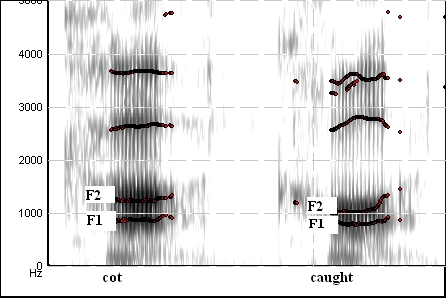Merger in Minnesota
Christina M. Esposito - esposito@maclacester.edu
Kaitlyn Arctander - karctand@macalester.edu
Hanna P. Kinney - hpkinney@gmail.com
Department of Linguistics
Macalaester College
1600 Grand Ave
St. Paul MN 55150
Popular
version of paper 1aSC4
Presented Monday morning, October 26, 2009
158th ASA Meeting, San Antonio, TX
When the poet Odgen Nash wrote As a tot, was I tawddling, or was I toddling? in This is My Own, My Native Tongue, he was referring to one of the most pervasive sound changes in American English, known to linguists as the low-back vowel or cot-caught merger. This sound change merges the vowel sounds in words like cot and caught, so that for some speakers these two words are homophonous.
In standard descriptions of American English, the vowels in words like caught are distinct from the vowels in words like cot. To indicate that these vowels are distinct, linguists transcribe the vowel in the word cot with the symbol [ɑ] and the vowel in the word caught with the symbol [ɔ]. However, for many American English speakers these two vowels are not distinct. In fact, current linguistics observation (Labov et al. 2006) suggests that this is now the dominant trend in American English, and that these two vowels are merging into one. For an ever increasing number of American English speakers, words like cot and caught are just as homophonous as pair and pear. Below are some examples of the different pronunciation of these vowels by three native speakers of American English.
|
|
Speaker 1 |
Speaker 2 |
Speaker 3 |
|
cot |
|
||
|
caught |
|
Table 1. Pronunciations of cot and caught by three speakers of American English.
Speaker 1 pronounces these two words with distinct vowels. The word cot is pronounced with the [ɑ] sound and the word caught is pronounced with the [ɔ]. Speaker 2 merges these two vowels and produces the words cot and caught with the vowel [ɑ]. Speaker 3 also mergers these two vowels but, unlike Speaker 2, merges them to [ɔ].
In our study, we examined the pronunciation of the vowels [ɑ] and [ɔ] in Minnesotan English. More specifically, we asked speakers of Minnesotan English, specifically the dialect spoken in the Twin Cities, to say a list of words that contained either the vowel [ɑ] or [ɔ]. Some of the words are presented in the table below. When you read the table, you might want to think about how you would pronounce these words.
|
Words traditionally pronounced with [ɑ] |
Words traditionally pronounced with [ɔ] |
|
Don |
Dawn |
|
Otto |
auto |
|
pa |
paw |
|
sod |
sawed |
Table 2. Sample wordlist. Column 1 contains words traditionally pronounced with [ɑ]. Column 2 contains words traditionally pronounced with [ɔ]
After we recorded the speakers, we measured the acoustic properties of their vowels to see if their [ɑ] and [ɔ] were the same or different. Specifically, we measured the first and second formants. Formants are the frequency components of sound. Different vowels have different formant values. Therefore, knowing the formant values of the vowels can tell us what the vowel is and whether two vowels are the same or different. Visual representations (called spectrograms) of cot and caught by a speaker who does not merge (Figure 1) and a speaker who does merge (Figure 2) are presented below. The first, second, third, and fourth formants are highlighted in red and the first and second formants are labeled F1 and F2, respectively.

Figure 1. Spectrogram of cot and caught The first, second, third, and fourth formants are outlined in red. The first (F1) and second (F2) formants are labeled for each word.
The speaker who produced the words cot and caught presented in Figure 1 does not merge these two vowels. Notice how his F1 and F2 in the word cot are higher than his F1 and F2 in the word caught. This is an indication that these two vowels sound different and are not merged.

Figure 2. Spectrogram of cot and caught The first, second, third, and fourth formants are outlined in red. The first (F1) and second (F2) formants are labeled for each word.
However, the speaker who produced the words cot and caught presented in Figure 2 does merge these two vowels. Notice how his F1 and F2 in the word cot are the same as his F1 and F2 in the word caught. This is an indication that these two vowels sound the same and are merged.
In our study, we found that 70 percent of the speakers did not merge the vowels in question. The 30 percent that did merge always merged to the vowel [ɑ]. The group of speakers that merged the vowels did not have anything in common (location, age, gender, etc.) that would distinguish them from the group that did merge the vowel.
These results were surprising because the cot-caught merger is reportedly pervasive in the Mid-West and in American English in general. In the future, we would like to record subjects of other dialects of Minnesotan English (recall that only speakers from the Twin Cities were used in the current study) and other Mid-Western dialects to see how the cot-caught merger patterns in these regions.